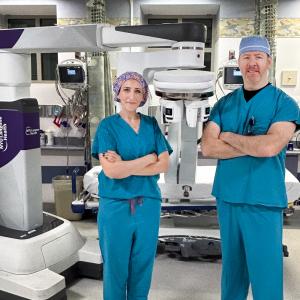When Artie Zuckerman Was Diagnosed with Prostate Cancer, Doctors at Perlmutter Cancer Center Helped Him Cut Through the Confusion & Navigate His Treatment Options with Confidence

Like many men, Artie Zuckerman had virtually no symptoms when he was diagnosed with prostate cancer at age 68. A fitness enthusiast who gets plenty of exercise caring for his three Great Danes, he felt blindsided. “I thought I was doing pretty good,” he recalls.
Photo: Brad Trent
At 68, Artie Zuckerman had a 31-inch waist, a 46-inch chest, and could knock out 20 chin-ups. “I was exercising, eating my fish and veggies,” recalls the Staten Island native, who works as a chauffeur and personal assistant for a corporate CEO. “I thought I was doing pretty good.” Aside from getting up to go to the bathroom twice a night—common for men his age—he felt vibrant. So when tests showed that Zuckerman had prostate cancer, his fear was mingled with a sense of disbelief.
Like many of the more than 174,000 men diagnosed with the disease annually in the United States, he faced an agonizing decision. “For patients with prostate cancer, choosing a course of action can be overwhelming,” says Herbert Lepor, MD, the Martin Spatz Chair of the Department of Urology and director of the Smilow Comprehensive Prostate Cancer Center, part of Perlmutter Cancer Center at NYU Langone Health.
A decade ago, the vast majority of patients diagnosed with prostate cancer opted for a radical prostatectomy—surgical removal of the prostate—or radiation therapy. However, today almost half choose active surveillance, in which slow-growing early-stage tumors are monitored through a combination of a blood test that measures a protein known as prostate-specific antigen, or PSA, and biopsies. This trend reflects a raft of recent studies showing that prostate tumors rated 6 or less on the Gleason scale (a 1 to 10 measure of likely aggressiveness) rarely metastasize. Still, many patients are uncomfortable with a watch-and-wait approach, and it’s typically not an option in higher-risk cases like Zuckerman’s. Then, the choices become more complex.
VIDEO: Dr. Herbert Lepor, Dr. James S. Wysock, and Dr. Samir Taneja discuss focal therapy and who are the most suitable candidates for the procedure.
Zuckerman’s MRI scan revealed a gumball-size tumor, and biopsies showed a Gleason score of 7, indicating an intermediate risk that the cancer would spread beyond the prostate. He visited several specialists, each of whom suggested a different type of treatment. He took to the internet, as many patients do, in search of information and talked with friends who’d undergone treatment for prostate cancer. But his confusion only intensified; he simply couldn’t find a consensus on which treatment was best. Finally, he consulted Dr. Lepor, whose approach put him at ease. “He spent an hour with me,” Zuckerman recalls. “I was impressed with his experience, his confidence, and his honesty.”
As a leading prostate cancer surgeon, Dr. Lepor has performed more than 5,000 radical prostatectomies. Yet he has also helped pioneer a nonsurgical technique known as focal ablation, in which precisely targeted beams of energy, such as extreme cold or high-intensity ultrasound, destroy diseased tissue while leaving the rest of the prostate intact. Preliminary studies—including some by Dr. Lepor and his colleagues—suggest the method can eradicate tumors with fewer side effects than surgery or radiation. In addition, unlike with radiation, patients can undergo another round of focal therapy or opt for conventional methods in case of recurrence. “I told Artie that this could be a way to control his cancer with less risk of life-altering complications,” Dr. Lepor explains. “But I emphasized that there were no guarantees.”
“I told Artie that this could be a way to control his cancer with less risk of life-altering complications. But I emphasized that there were no guarantees.”—Dr. Herbert Lepor
Zuckerman was willing to take a chance. Because of the position of his tumor, among other factors, Dr. Lepor recommended focal cryotherapy, in which repeated freezing and thawing causes cancer cells to rupture. Last July, while Zuckerman was under anesthesia, Dr. Lepor inserted a thin probe into his prostate, using ultrasound guidance to reach the site of the tumor. He then cycled supercooled argon gas through the probe, chilling the target area to −40 degrees Celsius. The procedure took about two hours, and Zuckerman, like most patients, went home the same day. He returned to work 10 days later.
Since then, Zuckerman has experienced no incontinence, and his sexual function, though impacted at first, has returned to near normal. A follow-up PSA test, MRI, and biopsy after six months showed no cancer. (He’ll continue with PSA testing every six months.) “I think I did the right thing,” he says.
But ultimately every man with prostate cancer must make his own choice, notes Dr. Lepor. “This is a visceral decision,” he says. “One patient will insist on the most definitive cure. Another will accept some uncertainty if there’s less impact on quality of life. The doctor’s role is to provide realistic expectations, and help patients process the risks and benefits.”

